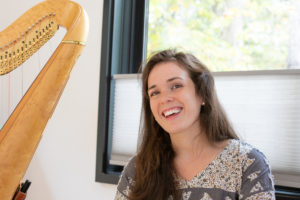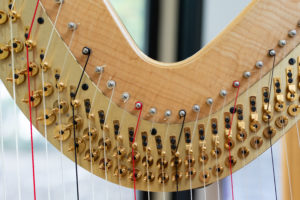By Alicia Stemper/Vitamin O
Although it is easy to immediately make beautiful music on the harp, mastering the instrument is difficult. Musician Leigh Stringfellow has loved the harp since she saw one at age four; she started playing at nine. The strings are the same as the white keys on a piano. Therefore, in addition to using both hands on the strings, a harpist also needs to use seven-foot pedals, “one for each note in the scale.” The D pedal, for instance, “moves all of the D strings from D flat to D natural to D sharp.”
Stringfellow further explains, “On the piano the keys are right there underneath your hands so you can find them as you need them. On the harp you have to get there in advance before you can play them …you have to be able to anticipate everything, which is what all good musicians do. Harpists just have to do it sooner.”
Stringfellow recalls a movement from Wagner where “… in two bars there are 25 pedal changes. It makes me a little nauseous thinking about it.” Still, she calls the harp “a heart-warming instrument…just the sound of the harp relaxes and stabilizes a heartbeat more than other instruments do.”
Stringfellow is the principal harpist for the Durham Symphony and she plays for weddings and other private events. She recently played with a piccolo concerto in Boone and she once played with the indie rock band, Lost in the Trees. She enjoys all the different avenues of performing, but “right now I get most excited about chamber music because I do it the least…you are collaborating in a different way.”
Harps are very old instruments, dating back almost 4000 years. Many visualize them as instruments played by angels. Interestingly, Stringfellow finds that Led Zepplin’s Stairway to Heaven “sounds really good on the harp.” Meanwhile, the music that reminds her most of Orange County is “definitely the banjo and bluegrass music because it goes back to what people were doing here in the 1800s.” Ironically, bluegrass is one of the only types of music not well-suited to the harp; it is “too fast and repetitive.”
Stringfellow devotes half her professional time to teaching lessons in her Carrboro studio. She individually tailors lessons to the “needs, desires, wants, and abilities” of her students, currently ages six through early 70s. Despite its difficulty, students find playing the harp very rewarding because “even really simple music just sounds gorgeous on the harp.” Three harps named Raphael, Lolita, and Oberon live in her studio; she also offers rental harps. Raphael (pictured) is clearly the king; made of maple and sitka spruce, he is over six feet tall and weighs 81 pounds.








